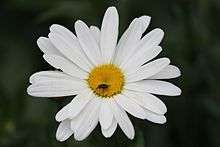Leucanthemum vulgare
| Leucanthemum vulgare | |
|---|---|
 | |
| Scientific classification | |
| Kingdom: | Plantae |
| Clade: | Angiosperms |
| Clade: | Eudicots |
| Clade: | Asterids |
| Order: | Asterales |
| Family: | Asteraceae |
| Genus: | Leucanthemum |
| Species: | L. vulgare |
| Binomial name | |
| Leucanthemum vulgare | |
| Synonyms[1] | |
| |
Leucanthemum vulgare, the ox-eye daisy,[2] or oxeye daisy,[3] is a widespread flowering plant native to Europe and the temperate regions of Asia and an introduced plant to North America, Australia and New Zealand. It is one of a number of family Asteraceae plants to be called a "daisy", and has the additional vernacular names common daisy, dog daisy and moon daisy.
L. vulgare is a typical grassland perennial wildflower, growing in a variety of plant communities including meadows and fields, under scrub and open-canopy forests, and in disturbed areas.[4]
Leucanthemum is from the Ancient Greek λευκός (leukós, "white") and ἄνθος (ánthos, "flower"). In plant symbolism, the ox-eye daisy represents patience.
This plant was top-ranked for pollen production per floral unit sampled at the level of the entire capitulum, with a value of 15.9 ± 2μl, in a UK study of meadow flowers. The corn poppy, Papaver rhoeas, was top-ranked for the per flower rate at 13.3 ± 2.8μl.[5]
Description

Leucanthemum vulgare is a perennial herb one to three feet high by 1 foot (0.30 m) wide.[6] The stem is mostly unbranched and sprouts laterally from a creeping rhizomatous rootstock.[7]
The leaves are dark green on both sides. The basal and middle leaves are petiolate, obovate to spoon-shaped, and serrate to dentate. The upper leaves are shorter, sessile, and borne along the stem.
L. vulgare blooms from late spring to autumn. The small flower head, not larger than 5 centimetres (2.0 in), consists of about 20 white ray florets that surround a yellow disc, growing on the end of 1 to 3 ft (30 to 91 cm) tall stems. The plant produces an abundant number of flat seeds, without pappus, that remain viable in the soil for 2 to 3 years. It also spreads vegetatively by rhizomes.[7]
 L. vulgare plant after flowering, showing the foliage.
L. vulgare plant after flowering, showing the foliage.- Capitulum of L. vulgare from below, showing the involucral bracts.
Uses
Food
The unopened flower buds can be marinated and used in a similar way to capers.[8]
Grieve's Modern Herbal (1931) states that "The taste of the dried herb is bitter and tingling, and the odour faintly resembles that of valerian."[9]
Cultivation
Leucanthemum vulgare is widely cultivated and available as a perennial flowering ornamental plant for gardens and designed meadow landscapes. It thrives in a wide range of conditions and can grow in sun to partial shade, and prefers damp soils. There are cultivars, such as 'May Queen' which begins blooming in early spring.
Invasive species
Leucanthemum vulgare became an introduced species via gardens into natural areas in parts of Canada,[2] the United States, Australia, and New Zealand (where it is now a common weed).[10] In some habitats it is an invasive species forming dense colonies displacing native plants and modifying existing communities, and is classified as a noxious weed.[4][11][12]
It commonly invades lawns, and is difficult to control or eradicate, since a new plant can regenerate from rhizome fragments[4] and is a problem in pastures where beef and dairy cattle graze, as usually they will not eat it, thus enabling it to spread.[13]
 Infestation in native pasture near Guyra in Australia
Infestation in native pasture near Guyra in Australia
Ox-eye daisy is a host for several viral diseases affecting crops.[7]
Allergies
Allergies to daisies do occur, usually causing contact dermatitis.[14]
See also
- Bellis perennis – common daisy
- Buphthalmum salicifolium – yellow ox-eye daisy
- Argyranthemum frutescens – marguerite daisy
References
- ↑ "The Plant List: A Working List of All Plant Species". Retrieved 5 December 2014.
- 1 2 T. Dickinson; D. Metsger; J. Bull; R. Dickinson (2004). ROM Field Guide to Wildflowers of Ontario. Toronto: Royal Ontario Museum. p. 175.
- ↑ "BSBI List 2007". Botanical Society of Britain and Ireland. Archived from the original (xls) on 25 January 2015. Retrieved 17 October 2014.
- 1 2 3 "Ox-Eye Daisy – Chrysanthemum leucanthemum". cirrusimage.com.
- ↑ Hicks, DM; Ouvrard, P; Baldock, KCR (2016). "Food for Pollinators: Quantifying the Nectar and Pollen Resources of Urban Flower Meadows". PLoS ONE. 11 (6). doi:10.1371/journal.pone.0158117.
- ↑ "Ox-eye Daisy (Leucanthemum vulgare) – Information on Ox-eye Daisy – Encyclopedia of Life". Encyclopedia of Life.
- 1 2 3 Ox-Eye Daisy – Chrysanthemum leucanthemum. Cirrusimage.com. Retrieved on 2015-07-08.
- ↑ "Forbes Wild Food". wildfoods.ca. Archived from the original on 2007-03-13.
- ↑ Grieve, Maud (1971). A Modern Herbal: The Medicinal, Culinary, Cosmetic and Economic Properties, Cultivation and Folk-lore of Herbs, Grasses, Fungi, Shrubs, & Trees with All Their Modern Scientific Uses, Volume 1. p. 248.
- ↑ oxeye daisy, Leucanthemum vulgare (Asterales: Asteraceae). Invasive.org (2010-05-04). Retrieved on 2015-07-08.
- ↑ "Plants Profile for Leucanthemum vulgare (oxeye daisy)". usda.gov.
- ↑ "UC/JEPS: Jepson Manual treatment for LEUCANTHEMUM vulgare". berkeley.edu.
- ↑ Oxeye daisy. massey.ac.nz
- ↑ Lynette A. Gordon (1999). "Compositae dermatitis". Australasian Journal of Dermatology. 40 (3): 123–130. doi:10.1046/j.1440-0960.1999.00341.x. PMID 10439521.
Further reading
External links
| Wikimedia Commons has media related to Leucanthemum vulgare. |